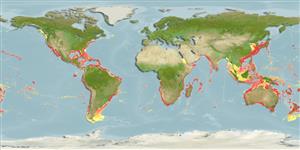Classification / Names
Common names from other countries
Main reference
Size / Weight / Age
Max length : 250 cm TL male/unsexed; (Ref. 27865); common length : 80.0 cm TL male/unsexed; (Ref. 9137); max. published weight: 96.8 kg (Ref. 40637); max. reported age: 12 years (Ref. 72462)
Length at first maturity
Lm ?, range 51 - ? cm
Environment
Marine; brackish; benthopelagic; depth range 3 - 825 m (Ref. 4517)
Climate / Range
Subtropical; 18°C - 24°C (Ref. 6390), preferred 25°C (Ref. 107945); 55°N - 57°S, 180°W - 180°E
Distribution
Circumglobal in subtropical waters: Series of disjunct populations. Indo-Pacific: South Africa, Walter Shoals, Amsterdam Island, Japan, Australia, New Zealand, New Caledonia, Hawaii, Rapa, Pitcairn Island, and Easter Island. Eastern Pacific: British Columbia, Canada to Chile (Ref. 2850), including Desventuradas Is. and Juan Fernández Is. (Ref. 89357). Eastern Atlantic: St. Helena, South Africa (Ref. 7097).
Countries | FAO areas | Ecosystems | Occurrences | Introductions
Short description
Dorsal
spines
(total): 5 - 6;
Dorsal
soft rays
(total): 33-35;
Anal
spines: 2-3;
Anal
soft rays: 20 - 21. The only jack without scutella on the caudal peduncle. Dark blue dorsally and almost white ventrally; with a well defined line of demarcation between the two colors.
IUCN Red List Status (Ref. 115185)
Human uses
Fisheries: minor commercial; aquaculture: experimental; gamefish: yes
Tools
Special reports
Download XML
Internet sources
Estimates of some properties based on models
Phylogenetic diversity index
PD50 = 0.5020 many relatives (e.g. carps) 0.5 - 2.0 few relatives (e.g. lungfishes)
Trophic Level
4.2 ±0.1 se; Based on diet studies.
Resilience
Low, minimum population doubling time 4.5 - 14 years (K=0.13; tm=2; tmax=12)
Vulnerability
High to very high vulnerability (69 of 100)
Price category
